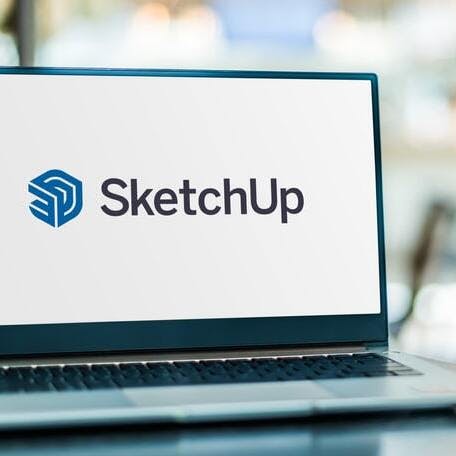
Fusion® vs. SketchUp – Software Comparison
Learn more about the differences between these two software and when to use them.

Fusion® and SketchUp are both relative newcomers in CAD modeling, and they’re both very popular. Fusion integrates parametric and surfacing methods as well as CAM (computer-aided manufacturing), animation, image rendering, simulation tools, 2D part drawing, and 3D printing. SketchUp, on the other hand, is built to ease the production of 3D design. It provides a simplified user experience and fast learning of basic design tools. The core software has a wide range of specialist plug-in modules for added capabilities.
While these packages look like polar opposites, they can serve exactly the same uses in a wide range of settings. SketchUp feels stripped down and makes starting out easy. Its user interface is simple, whereas Fusion feels much more like a more traditional CAD. SketchUp is a lightweight 3D modeling core with a wide range of plug-in tool kits, whereas Fusion has all the tools on hand, with more redundancy.
These differences are the result of different philosophies in the origin of the software. One aims for high capability from the start, while the other aims for frictionless learning and added tools when required. This article will further compare Fusion vs. SketchUp in terms of applications, system requirements, file formats, user experience, and price.
What is Fusion?
Fusion provides a simplified version of the majority of the tools of more complex CAD packages. The top-tier CAD packages used by the more advanced design processes are very expensive to buy and support. Fusion looks to provide basic-level functionality at a moderate cost. It is faster and more adaptable than top-tier packages like Inventor® and SolidWorks® for new and occasional users. Fusion is best for applications in which relatively simple individual parts and assemblies are modeled.
Users who are not making complex surface curvature-based designs or large assemblies simply have less to learn to get started. As an introduction to the world of CAD, Fusion meets all of the new user’s requirements. Also, for those whose skills develop to surpass its free capabilities, the license is not overwhelmingly expensive. For more information, see our guides on About 3D Printing and 3D Printing Software list.
What is SketchUp?
SketchUp is a linear and polygonal 3D drawing system. It contains a selection of plug-ins such as: Selection Toys, 1001Bit Tools, Curviloft, Sandbox bonus tools, TopoShaper, Artisan SketchUp extension, 3D Tree Maker SketchUp extension, and Angular Dimension. SketchUp’s user interface is not like most CAD programs; it sets the user up to try things quickly. It runs smoothly and reliably on quite ordinary computers, unlike high-end CAD options.
Fusion vs. SketchUp – Use Cases and Applications
There are many and varied use cases among hobbyists and non-commercial users for both packages, but a few applications stand out as more common and important. In the professional space, the two user groups have only limited common ground.
SketchUp is widely employed by carpenters and furniture makers, as well as in architecture and interior design. Its tools are intuitive and don’t get in the way of the creative process. SketchUp aids idea flow by allowing simple outlines to build in the complexity of form. It is used for building interiors and exteriors and offers rich shape development with limited learning.
Fusion, on the other hand, is a precision-oriented engineering design package. It has a good reputation in applications such as: mechanical design and engineering of products for aesthetics, form, fit, and function; easy PCB design; and printer/CAM integration. The close integration with 3D printing processes is widely employed in professional and hobby product design and manufacture, across all consumer, industrial, and medical product sectors.
Fusion vs. SketchUp – System Requirements
In terms of system requirements, SketchUp requirements are considerably lighter compared to Fusion. For Fusion, users are required to have the following:
- Windows: x86-based 64-bit processor, quad-core, 1.7 GHz or greater.
- macOS: Apple silicon processors require Rosetta 2.
- 4 GB of RAM, 6 GB minimum graphics memory.
- DirectX11 is recommended, including a dedicated GPU with min. 1 GB VRAM.
- Display resolution of 1920 x 1080 or greater recommended.
- 3 GB of disk space minimum.
SketchUp, on the other hand, requires the following:
- 2.4+ GHz processor.
- 8 GB RAM.
- 1 GB hard disk space.
- Video card 2+ GB 100% OpenGL.
- 3-button mouse with scroll function.
What is the Operating System of Fusion and SketchUp?
Fusion requires Windows 8.1 (until early 2023), 10 or 11, or macOS 12 Monterey, macOS11+ Big Sur, or macOS 10.15.7 (or newer) Catalina until early 2023. SketchUp, on the other hand, requires only a browser for the web (the free version). The installed version, however, requires Windows 11, Windows 10, macOS 12+ Monterey, 11+ Big Sur, or macOS 10.15+ Catalina.
What Are the Minimum Memory Requirements for Fusion and SketchUp?
The minimum memory requirements for Fusion are 4 GB of RAM, (though some recommend 6 GB for more stable operation) and 3 GB of free disk space. SketchUp, on the other hand, requires 4 GB of RAM and 500 MB of free disk space to install and run in a stable fashion.
What Are the Supporting File Formats of Fusion and SketchUp?
Fusion supports a range of standard CAD formats. SketchUp, on the other hand, works with a different range of file types, more prevalent in 3D visual design rather than product design. For more information, see our Guide to 3D Printing Files.
Some of the file types for both are listed in Table 1 below:
| Fusion | SketchUp |
|---|---|
Fusion OBJ STL STEP IPT SLDPRT | SketchUp OBJ STL SKP PNG JPG DWG DAE KMZ 3DS DEM FBX XSI VRML |
Fusion vs. SketchUp – User Experience
Fusion presents as traditional CAD whereas SketchUp has a very simple and more sketchbook feel to it. SketchUp is built to make 3D design simple and avoids overloading the new user. This clean workspace approach produces faster learning than Fusion.
Fusion contains built-in rendering capability, and SketchUp uses a range of tools to add these capabilities. It contains built-in tools for 2D drawings, offering export in DXF, DWG, and PDF formats. SketchUp is an assertively 3D tool, though SketchUp Pro and Studio include a well-integrated layout plug-in for 2D drawings. Fusion is a flexible, complete design tool that includes CAM and 3D printing tools, for vertical integration. SketchUp is a simpler tool with a close focus on 3D design for architects, woodworkers, and hobbyists.
Learning Curve of Fusion and SketchUp
Fusion provides basic surface, parametric, and direct tools, 2D drawing capability, plus printer/CAM communication, basic rendering, and some simulation tools. This is the full suite of 3D CAD tools, though most are lightweight. Once you're proficient, the package can fulfill most roles. But proficiency requires steep learning curves, particularly at the start.
SketchUp has the reputation of getting the user up and running fast with basic functionality, at least to the stage at which they can achieve useful work. The package, and particularly the free online version, is more limited in capability than Fusion. For the majority of hobby and home users, however, these limitations will not hold users back at all.
Is Fusion Easier To Learn and Use Than SketchUp?
No, Fusion is not easier to learn and use than SketchUp. SketchUp is considered significantly easier to learn because of its cut-down simplicity and ultra-clear user interface.
Fusion vs. SketchUp – Application Stability
Fusion is a relatively complex software system. This makes it a higher risk in stability terms, and this is evident in user discussions. Issues around graphics-card performance are not uncommon. SketchUp had issues with stability around new releases, which appears to relate to release quality in 2020. Various plug-ins have also developed reputations at times for crashing SketchUp. With new release issues, SketchUp seems to run in a stable and reliable fashion, other than when users run multiple instances.
Fusion vs. SketchUp – Customer Support
Fusion customer support is generally viewed positively compared to SketchUp. This positive view is in keeping with a long history of other Autodesk® software. Like all subscription services, there are reported issues relating to payments going wrong, but this does not appear to be a large-scale problem. Overall the service is viewed as at, or above average.
Fusion vs. SketchUp – Community
There are official and unofficial Fusion user forums that can be very useful in learning and problem-solving. The Reddit community is active and supported, with current discussions on a wide range of topics.
One feature of the SketchUp experience is a large number of active user groups (both official and user-driven) which are forums for file and experience sharing and great places to get real support from real users.
Fusion vs. SketchUp – Price
Both Fusion and SketchUp have a wide range of pricing structures, depending on the user's needs. For example, Fusion has personal, educational, startup, and full licenses available. The personal license is free but with reduced functionality. Both the educational and startup licenses, on the other hand, are free for up to three years with certain limitations including a revenue limit for the startup license. For the full license, users are required to pay a monthly fee of $60 for full access to tools.
For SketchUp, the free version is available on the web only, with several limitations including watermarked designs and 10 GB online storage. The paid versions start at $120 to $1,200, with several options including: SketchUp Shop, Pro, and Studio.
Other Alternatives to Fusion and SketchUp
Many CAD systems overlap in capability, so there’s a spectrum of alternatives from freeware to high-end CAD. Some alternatives include:
- Solidworks®
- Creo Parametric
- SolidEdge
- FreeCAD
- Altium (PCB specific)
Summary
This article presented Fusion and SketchUp, explained what they are, and discussed when to use each software. To learn more about 3D printing software, contact a Xometry representative.
Xometry provides a wide range of manufacturing capabilities, including 3D printing and other value-added services for all of your prototyping and production needs. Visit our website to learn more or to request a free, no-obligation quote.
Copyright and Trademark Notices
- Autodesk®, Fusion®, and Inventor® are trademarks of Autodesk, Inc., and/or its subsidiaries and/or affiliates, in the United States.
- Solidworks® is a registered trademark of Dassault Systèmes SolidWorks Corp.
Disclaimer
The content appearing on this webpage is for informational purposes only. Xometry makes no representation or warranty of any kind, be it expressed or implied, as to the accuracy, completeness, or validity of the information. Any performance parameters, geometric tolerances, specific design features, quality and types of materials, or processes should not be inferred to represent what will be delivered by third-party suppliers or manufacturers through Xometry’s network. Buyers seeking quotes for parts are responsible for defining the specific requirements for those parts. Please refer to our terms and conditions for more information.
